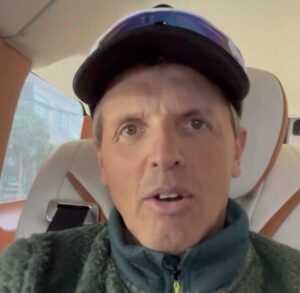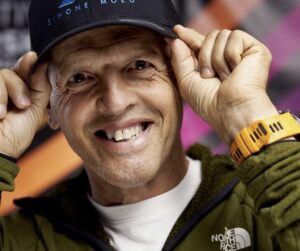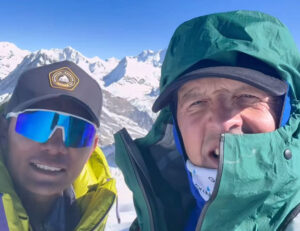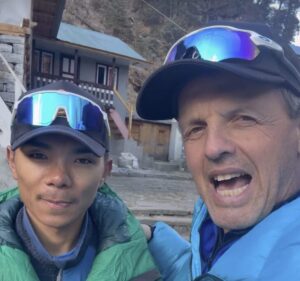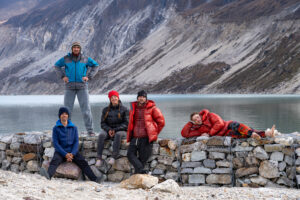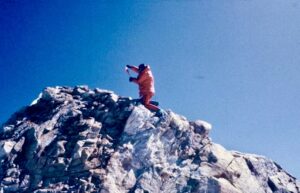Oswald Rodrigo Pereira first set foot in the Himalaya in 2018, not as a climber but as a cameraman. Since then, he has not missed a winter season. A trail runner, he showed his fitness at high altitude on Broad Peak last summer, where he became one of just three to summit. He has also witnessed some of the most dramatic mountain events of the last few years.
As you read this, Pereira is likely somewhere between the Polish border and Lviv, delivering supplies to Ukrainian hospitals.
Himalayan rookie
You went to the Himalaya for the first time as a photographer for the Polish national team’s 2018 K2 Winter expedition. How did you get onto the team?
I worked as a sports journalist for a Polish TV network and managed to get assigned the task. I was actually a reporter, not a cameraman. However, I didn’t want to let anyone else risk a winter Karakoram expedition, so I learned to work with cameras. Sometime later, they asked me to join further expeditions: Nanda Devi, Lhotse, and Batura Shar the following winter.

Pereira landed at winter K2 with no previous experience either as a photographer or at altitude. Months later, he started traveling as a photographer with the national Polish team. Above, Batura Shar.
What was your previous experience when you traveled to winter K2?
Well, actually none. Back then I tried to keep quiet about it because critics were fierce, but I trained really hard, slept in hypobaric chambers, and reached base camp healthy and fit. I was not meant to climb, so I had no problems not summiting and doing my work.
I discovered that I acclimatize well –- which is surprising since I’ve suffered from asthma since I was a child.
Winter K2
After Batura came the pandemic, and the Polish winter program was shelved. Then in the fall of 2020, Magdalena Gorzkowska hired him to film her attempt up K2, still unclimbed in winter, on a commercial expedition.
Pereira accepted although the choice cost him his job at the TV station. “They said they could not have me leaving for weeks every few months,” he explained. “It was a tough choice, because I have no sponsorships, nor do I look for them. I just want to film documentaries, then sell them to networks.”

Magdalena Gorzkowska on winter K2. Photo: Oswald Perieira.
Why did you leave a relatively safe job for such an uncertain expedition?
Because I had the feeling that the expedition was going to make history, and I just had to be there. It was also a game-changer in my career.
So on winter K2, you were there to document Gorzkowska. Were you ready to climb as far up as she did?
If possible, yes, of course. But my mission was clear: I was there to film. That certainly makes me more flexible. If I have enough material for a good documentary, I know it’s fine not to summit.

K2, winter 2020-2021. Photo: O.R. Pereira
Did you use supplementary O2?
I have never used it and I usually don’t want to. I discussed this during last winter’s attempt on Manaslu. Someone told me that I could risk my health by trying to film at altitude without O2, but that’s how I climb. Yet on Winter K2, I had this dilemma: Knowing how hard it would be, I might need it if Magdalena launched a summit push.
In the end, it was not necessary: When she fell sick on the last rotation, some people told me I had the strength to continue, but I chose to descend with her. That was my job.
The price is loneliness
Winter K2 had the most media coverage of any expedition in the 21st century. What did it mean to you?
It is one of those you read about in books for years to come. By then, I had been on four expeditions, but I had never experienced death so closely. Sure, the risk is always there, but I never really considered that someone in my team could die. But when Sergi Mingote had his accident, I was there and saw him fall. It was a shock. I had to ask myself seriously why we were there. We go to the mountains to enjoy life passionately, not to die. I had to accept that no one around me was safe, that each time I spoke to someone, it could be the last time I saw them alive.

Family and friends of the climbers who perished on winter K2 gather at the Gilkey Memorial in 2021. Photo courtesy of O.R. Pereira
And what have you learned from that?
I learned to appreciate life more and to see people in a different way. Months after the expedition, after my summer trip to Pakistan, I visited Sergi Mingote’s relatives and they welcomed me as a new member of the family. I felt I had seen death, seen people who lost their loved ones, and I gained a family. On an individual level, when I saw they brought Atanas Skatov’s body into Base Camp, and his girlfriend was there, I realized that if I intended to keep on this professional path, I simply couldn’t afford to have a family. The risk is too high. I cannot have a family and cause them the sheer pain I saw.
Do you still feel the same?
Yes, climbing and filming at altitude is my passion, and I accept the risk. But I won’t put anyone else in the middle. It’s the price to pay.

While climbing at high altitude, Pereira has decided to avoid having a family. But he does like dogs and volunteers at a shelter in Poland.Photo: O.R. Pereira
Rescue on Broad Peak
The following summer, you climbed Broad Peak and got involved in another drama…
Nils Jespers, Hugo Ayaviri, and I were the first to reach the summit. It was already very late. We had set a deadline of 3:30 pm and agreed that if any of us wanted to continue after that, the other two would have to convince him to forget it and go down. We reached the main summit at 3:15 pm.
As we descended, we saw people on their way up, including Mr. Kim, the Korean, and some Pakistani porters, but I can’t really tell how many and how far they got.
Eventually, I crossed paths with Nastya [Runova]. She asked me to wait for her, but I had to decline: I was exhausted, cold, hungry, and thirsty. I really needed to reach a camp. However, I said I would descend very slowly.
At the col, I met the Belgians: Nils Jespers, Sophie Lenaerts, and her husband (who had turned around at the foresummit). I stopped to take a picture of the sunset and then I noticed an SMS on my InReach. It was Nastya. She wrote, “Please wait!”

Pereira on the summit of Broad Peak, summer 2021.Photo: O.R. Pereira
I couldn’t help thinking that if something happened to her, I would have to live with that text on my conscience. I was also concerned about the Polish 2013 expedition and how the survivors were criticized. Although I had a right to go down and save myself, in the end, I waited. Then I retraced my footsteps and went up until I met Little Hussain, the Pakistani porter. He told me that Nastya was down there, on the Chinese side.
It took us two hours to get her out. It was 10 pm when she got back on the route and she had lost a crampon. Very carefully, we went down to the col where I melted some snow for water. The descent from the col throughout the night was extremely slow, five steps and stop, until 5 am. Some 50m above Camp 3, we met the Russians.
Kim HongBin’s fatal night
Did you see Kim HongBin, who somehow descended to the same ledge as Nastya? He spent the night there with no help and eventually fell to his death.
I only heard about Mr. Kim after returning to Base Camp.

Sunset from the saddle of Broad Peak.Photo: O.R. Pereira
You didn’t see him while you were helping Nastya Runova?
I saw someone, but I never noticed that it was him or that he was in any kind of trouble. As I was helping Nastya, I was also calling for someone else to help me. But everyone was somehow paralyzed up above.
Little Hussain and I managed to get her out. Since she was in shock and exhausted, I started immediately down with her. Little Hussain remained there and I supposed he would help [the person] I thought was a second porter.
By then, more people were going down. It was only when I returned to BC that I learned that Mr. Kim had apparently rappelled down to the place where Nastya was. Of course, if I had known he was there, I would have stayed to help.
After Broad Peak, Pereira’s summit partners Ayaviri and Jespers climbed K2 in perfect weather, but he gave up his attempt in order to film a tribute at Gilkey’s Memorial by the relatives and friends of the climbers who perished on K2 the previous winter.
An apocalypse of snow on Manaslu
Then, as winter approached, you showed up on Manaslu. Was it a last-minute decision or did you have it planned?
I had started planning for Manaslu in September. Simone [Moro] and Alex [Txikon] planned to take Sajid Sadpara with them, and I thought that would be a good story to film. Finally, Sajid dropped out, but by then I had the plan in mind and the camera ready, so I went.

Winter Manaslu under the stars.Photo: O.R. Pereira
It seems that your trips to the mountains are focused on filming rather than climbing.
Yes, that’s true. It is my profession. I met Alex Txikon at a book fair in November and told him about my plans to join the Manaslu expedition. As for Simone Moro, I only met him in Base Camp.
There was not much climbing on that expedition, was there?
Yeah, I would have liked to have climbed a little more. But several people had warned me that Manaslu is far too overloaded with snow in winter. And they were right: I have never seen so much snow falling in the Himalaya. An apocalypse of snow.
Three hours, 200m
Do you think the climbing team did everything possible to climb Manaslu? Were conditions that bad?
I can tell you that on January 4, I climbed to Camp I and beyond with four Sherpas. Past Camp 1, we only managed to cover 200m in three hours. The amount of snow up there was mind-blowing.
Yet we thought that perhaps if we had a long good weather window, conditions might improve, so we stayed. But since Alex Txikon and Simone Moro, who are far more experienced than I, considered the mountain was not fit to go further up, I was not going to be the crazy man who climbed alone.

Winter Manaslu was an “apocalypse of snow”, says Pereira. Photo: O.R. Pereira
Did you get enough footage?
Sure, I’ll have my documentary. After returning, I spoke to the Polish climber who first summited winter Manaslu. He told me how hard it was back then. He suggested something that Simone Moro had told me in Base Camp: that the mountains remain the same, but the climbers have changed.
In what sense? Are they softer?
Nowadays, climbers have a better life year around. They have more money and sponsorship. The Polish climbers back in the 1980s were ready to risk a lot in order to be accepted in an expedition. It was their only chance to climb abroad. Once there, they knew that if they proved strong, skilled, and a good teammate, they might go on the next one. So they were ready to give their all, in whatever conditions.
The war next door
Finally, you returned home and found a war unfolding almost in your backyard. Tell us about your aid work in Ukraine.
Soon after the war broke out, I started helping refugees get to Warsaw. Then I was contacted by Alex Txikon, who wanted to collaborate through a local charity. They brought a bus filled with supplies to the border. On the way back, they took in refugees who would be hosted by families in Spain.
We have now done several trips between Bilbao and Warsaw, and I know better what kind of items are really needed in Ukraine. Mainly, medical supplies for hospitals. So after the first trip, I loaded my van and drove to Lviv in order to deliver the aid as fast as possible. Tomorrow I’ll drive there again.

Periera has moved fast to help Ukraine. Photo: Jacek Prondzynski
There’s been some shelling and bombing there, too.
I am careful, of course, and I assess the situation constantly. If things got really ugly, I’d stop at the border, but so far it’s been almost quiet. Yeah, we can have the odd missile hitting the place, but that is a risk I can take for now.

